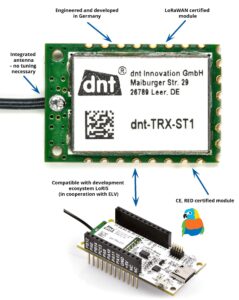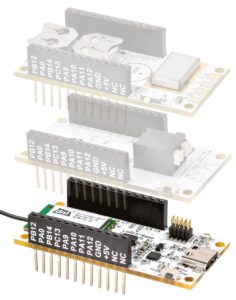The dnt-TRX-ST1 is an STM32 LoRaWAN module with an integrated antenna. From the German company dnt, it facilitates the development of LoRa end-devices by reducing the time to market and creating a more flexible development environment. The dnt-TRX-ST1 includes an STM32WLE5JB, the first MCU with a LoRa transceiver. The microcontroller features 48 KB of RAM and 128 KB of flash. dnt also tuned the antenna for the European spectrum, meaning frequencies between 865 MHz and 869.65 MHz. Moreover, the company, in cooperation with ELV Elektronik AG, offers the LoRIS-BM-TRX1. The development board contains the dnt-TRX-ST1, which runs the LoRa stack and application, thus encouraging experimentation.
Reason 1: Faster Time to Market
Acquiring the dnt-TRX-ST1 vs. Designing a Module From Scratch

Many engineers often struggle when choosing whether to design something from scratch or use existing solutions. To answer this question, let’s look at how dnt came up with the dnt-TRX-ST1. After talking with the German team, we learned that they used ST data sheets and development boards, like the NUCLEO-WL55JC. They checked the Nucleo’s Gerber file when designing the PCB and studied the MCU’s documentation. dnt also began writing their code by first using ST demos and testing AT commands. They then ported the solution to a full-fledged module and custom board.
The dnt-TRX-ST1 thus serves as a symbol because, in many instances, engineers working on their custom design will go through the same experience only to arrive at a similar result. They will use the same ST development tools, demos, and documentation. PCB considerations will be identical, and there’s little room for significant optimizations. Hence, engineers must decide if investing in a design they can already acquire makes sense. Unless companies deal with huge volumes or have particular requirements, most will choose to save time and money. It also means that many teams can simply focus on the application that will run on the STM32 to create distinctive features.
Using an Integrated Antenna vs. Designing One
Another essential consideration when conceiving a LoRa module is the antenna. Knowing how to design and tune it is challenging. Choosing suitable filters, installing the proper baluns, and figuring out the right power devices are tricky. Moreover, any mistake will have catastrophic effects since the product won’t receive regulatory approvals. The dnt-TRX-ST1 solves this by including the antenna inside its module. Engineers don’t have to worry about matching operations or spend time and money hiring necessary talents. Indeed, since the dnt module received CE and RED certifications, the end-device should have a far smoother time obtaining them.
Reason 2: More Flexible Development
The LoRIS Development Environment

Too often, companies underestimate the importance of experimenting with technologies. Being able to build proofs-of-concept rapidly can have many long-lasting advantages. However, designing everything from scratch may discourage experimentations because every little trial demands massive investments. In cooperation with ELV Elektronik AG, dnt offers a solution to this issue with the LoRIS platform. Indeed, ELV Elektronik AG provides daughterboards that sit on top of the LoRIS-BM-TRX1. Some include GPS, while others feature energy harvesting or environmental sensors. Hence, engineers can try different applications, test low power settings with the button cell module, and more.
Flasher Tool or STM32CubeIDE
Additionally, a flashing tool can load firmware onto the LoRIS-BM-TRX 1, and thus the dnt-TRX-ST1. However, it is also possible to use STM32CubeIDE, ST’s development environment, thus increasing flexibility. Moreover, developers can choose to start working with the NUCLEO-WL55JC then port the code onto the dnt-TRX-ST1 since they both use the same MCU. Teams can thus more easily test their LoRa stack and their application independently. Such flexibility is essential for industrial systems. Indeed, some require custom LoRa firmware, while others are fine with default stacks. By choosing an STM32WL solution like the dnt-TRX-ST1, engineers can focus on what they wish to prioritize instead of every aspect of the firmware.
